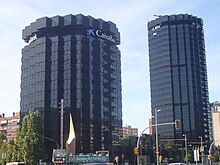La Caixa
 | |
 | |
| La Caixa | |
Native name | Fundación Bancaria Caixa d'Estalvis i Pensions de Barcelona, "la Caixa" |
| Formerly | Caixa d'Estalvis i Pensions de Barcelona, "la Caixa" |
| Company type |
|
| Industry | Social work; Financial services |
| Predecessors | |
| Founded | 1990 |
| Headquarters | CaixaForum Palma, , Spain |
| Revenue | 530,000,000 Euro (2023) |
| Total assets | 26,614,033,000 Euro (2022) |
| Website | fundacionlacaixa |
La Caixa, also known as the "La Caixa" Foundation (Spanish: Fundación ”la Caixa”), is a not-for-profit banking foundation based in Catalonia.[1]: 1 Originally a savings bank (caja), it reorganized in the 2000s and 2010s: Its commercial assets are managed under its subsidiary CriteriaCaixa, which also has partial ownership of La Caixa's old banking business CaixaBank; those are used to fund La Caixa's Obra Social — social, cultural, scientific, and civic projects for the public good.[1]: 5 [2]
Its official home is in Palma de Mallorca.[1]: 1
History[edit]
The foundation commonly dates itself to the 1990 creation of the Caixa d'Estalvis i Pensions de Barcelona (Spanish: Caja de Ahorros y Pensiones de Barcelona, "La Caixa") as a merger of the Caja de Ahorros y Monte de Piedad de Barcelona founded in 1844 and commonly known as Caja de Barcelona, founded in 1844, with the Caja de Pensiones para la Vejez y de Ahorros de Cataluña y Baleares, founded in 1904[1]: 1 and commonly known as the "Caja de Pensiones" and later "La Caixa".[3]: 4
Ancestry[edit]
Caja de Barcelona[edit]
At the time of the 1990 merger, the Caja de Barcelona was the third largest savings bank in Spain.[3]: 7
Caja de Pensiones[edit]
The Caja de Pensiones para la Vejez (English: Old Age Pension Society) was formed in 1904 in Catalonia by Francesc Moragas, and opened to the public in 1905, expanding to the Balearic Islands in 1915.[3]: 1 It merged with the Caja de Ahorros del Empordà in 1915, taking on the name "Caja de Pensiones para la Vejez y Ahorros".[3]: 2
The Obra Social was formally created in 1918 to oversee the Caja's social work.[3]: 2
By 1930, the Caja had been reformed 15 times by mergers with other organizations; the first outside of Catalonia was the Caja Rural para la Federación Católico-Agraria de Ibiza in 1930.[3]: 3
In 1969, the Caja de Pensiones became the first in Europe to begin real-time computerized tele-processing of transactions, allowing customers to do banking at any branch at will.[3]: 4
In the late 1980s, the Caja de Pensiones, by then known commonly known as "La Caixa", began work to expand outside of its usual territory: In 1986 it formed GrupCaixa to get around then-restrictive geographic limitations in the law; GrupCaixa was folded back into La Caixa in 1989 when the limitations were removed.[3]: 7
By the time of the 1990 merger, La Caixa was already the largest savings bank in Spain.[3]: 7
1990 organization[edit]
On 27 July[citation needed] 1990, the Caja de Barcelona, and La Caixa, also formerly called the Caja de Pensiones, merged to form the Caja de Ahorros y Pensiones de Barcelona, which itself continued the name "La Caixa".[3]: 4
In 1995, La Caixa opened the first international representative offices in Porto, Portugal and Brussels, Belgium.[4][failed verification]
In November 2006, the Board of Directors of La Caixa approved the IPO of its investee portfolio, through the company Criteria CaixaCorp, which became effective on 10 October 2007.[citation needed]
In January 2008, La Caixa bought part of Morgan Stanley's private banking business in Spain for almost 600 million euros and in 2010, the group acquired Caixa Girona, being one of the three savings bank integration operations that did not require assistance from the FROB (Fund for the orderly restructuring of the banking sector).[citation needed]
On 29 January 2008, Criteria CaixaCorp was included in IBEX 35.[5] In addition, La Caixa acquired 14.91% of Bank of East Asia's capital.
It has a portfolio of industrial holdings in companies in the infrastructure, energy and communications sectors, among others.[6]
Segregation of the banking business at CaixaBank and restructuring of the group[edit]
This section may be confusing or unclear to readers. (April 2021) |

On 27 January 2011, within the context of the restructuring of the financial system in Spain, the board of directors of La Caixa unveiled a complete reorganization of the group. The savings bank would transfer its banking business entirely (office network, client portfolio, assets, bank capital,...) to a subsidiary in which the majority of shares are held by the same savings bank (74%),[7] which adopted the name of CaixaBank, and was formerly known as Criteria CaixaCorp.
In this way La Caixa ceased to conduct retail banking business, and its only activity was limited to the maintenance of La Caixa Social Work Project. Although the savings bank no longer operates financially, CaixaBank decided, in its offices and in the commercial relationship with its customers, to use the commercial pseudonym of La Caixa, leaving the brand "CaixaBank" solely for institutional use.
At the same time, in July 2011, another subsidiary of the group was created, in this case 100% owned by La Caixa, called Criteria CaixaHolding, which would not list on the stock exchange and would bring together the less attractive stocks such as real estate services (Servihabitat) and industrial holdings (Gas Natural Fenosa, Abertis...) and PortAventura World.
CaixaBank which is publicly traded, remained at the helm of the banking business, the insurer (SegurCaixa) and the more financially attractive shares in foreign banks and in Telefónica and Repsol.
In September 2011, CaixaBank acquired Bankpyme's banking and fund management business.
In March 2012, the group announced an agreement whereby it acquired for 979 million euros and subsequently integrated within CaixaBank the SIP (Institutional Protection Scheme) formed by Cajasol (including Caja de Guadalajara), Caja Navarra, CajaCanarias and Caja de Burgos, commercially known until then as Banca Cívica (Civic Bank). The "Civic Bank" brand was discarded and the SIP was liquidated, transferring its clients, offices and assets to CaixaBank. However, due to its cultural roots, the entity decided to maintain the savings banks' logos that gave rise to the integration in its offices and communications in the offices, combining them with that of the Catalan bank, but only in the territories of influence of each entity.[8]
On 12 June 2013 the General Shareholders' Meeting of Banco de Valencia approved its integration into CaixaBank. It was agreed to maintain the Banco de Valencia brand in the offices held by the bank in the provinces of Valencia and Castellón with a dual label to indicate that they also belong to CaixaBank.[9]
On 19 July 2013 the merger deed of Banco de Valencia and CaixaBank was registered in the commercial register, and the integration of Banco de Valencia into CaixaBank became fully effective.[10]
After the absorption of Banco de Valencia by CaixaBank, both the offices of La Caixa and those of Banco de Valencia in the Region of Murcia regained the name of “Banco de Murcia", next to the star denoting La Caixa.[11]
Transformation into a banking foundation[edit]
This section may be confusing or unclear to readers. (April 2021) |

On 10 April 2014 it was announced that its transformation into a banking foundation would be decided at the ordinary general meeting on May 22 to comply with the Savings Banks and Banking Foundations Law, which requires savings banks with indirect banking activity to be liquidated and transformed into foundations, responsible for managing social work projects. This would lead to a process of reorganization within the group, which would involve, on the one hand, the dissolution and liquidation of the La Caixa Foundation and, on the other hand, the transfer to Criteria CaixaHolding (100% of La Caixa) of the participation in CaixaBank.[11]
On 22 May 2014, the general assembly of La Caixa approved its transformation into a banking foundation.[12]
The foundation was established on 17 June 2014. As a result, on the one hand, the dissolution and liquidation of the La Caixa Foundation would occur, with the overall transfer of its assets and liabilities in favour of the La Caixa Banking Foundation, and, on the other hand, the transfer in favour of Criteria CaixaHolding of the participation of the Caixa at CaixaBank, so that the banking foundation would go on to hold its stake in CaixaBank through Criteria CaixaHolding, and the debt instruments of which La Caixa was the issuer. In this way, the group led by the new La Caixa Banking Foundation would have as main activities: the management of the entire Social Work, those of a financial nature related to the management of its participation in CaixaBank, the administration of the debt instruments that have La Caixa as an issuer, and the management of investments in industries other than finance grouped so far in Criteria CaixaHolding.[13] The liquidation of the La Caixa Foundation took place on 16 October 2014 while the transfer of the stake in CaixaBank took place on 14 October 2014.[14]
On 26 June 2014, the president of CaixaBank and until then president of the savings bank, Isidro Fainé, was elected president of the Board of Trustees of the La Caixa Banking Foundation.[15]
Participation[edit]
The La Caixa Banking Foundation manages the Group's shareholdings through Criteria Caixa (formerly Criteria CaixaHolding), an equity instrumental company fully controlled by the foundation. The shares of Criteria Caixa include the ones owned in CaixaBank (as of 31 December 2018: 40.00%),[4] as well as those held in several companies including Cellnex, Naturgy, Saba, Suez and Telefónica.
Social work[edit]
As explained above, since September 2014, La Caixa Banking Foundation is responsible for managing the social work projects of the former savings bank. Until then, this work was carried out by the La Caixa Foundation.
In 2018, the La Caixa Banking Foundation had an allocated budget of 520 million euros. The foundation, one of the most significant worldwide, supported more than 11 million people in 2017, through nearly 50,000 initiatives.[15] According to the OECD, La Caixa Banking Foundation's financing for 2019 development increased by 58% to US$33.9 million.[16]
See also[edit]
References[edit]
- ^ a b c d "Bylaws of Fundación Bancaria Caixa D'Estalvis i Pensions de Barcelona, "La Caixa"" (PDF). Palma de Mallorca: "la Caixa" Foundation. 2018. Retrieved 2021-04-17.
- ^ "The business assets management model". Annual Report 2020. Palma de Mallorca: "la Caixa" Foundation. pp. 68–69. Retrieved 2021-04-17.
- ^ a b c d e f g h i j "History of the Group" (PDF). CaixaBank. 2017-03-03. Retrieved 2021-04-17.
- ^ a b "Caixabank Financial Statements 2018" (PDF). caixabank.com. Retrieved 21 January 2024.
- ^ Protocol frob.es [dead link]
- ^ "Criteria CaixaCorp joins the IBEX-35 index" (PDF). caixabank.com. 29 January 2008. Retrieved 21 January 2024.
- ^ "The Bank of East Asia". CriteriaCaixa. Retrieved 2019-10-31.
- ^ CNA. "Barcelona-based CaixaBank buys Banca Cívica for €1 billion and becomes Spain's largest bank". www.catalannews.com. Retrieved 2019-10-31.
- ^ CNA. "Barcelona-based CaixaBank buys Banca Cívica for €1 billion and becomes Spain's largest bank". www.catalannews.com. Retrieved 2019-10-31.
- ^ "CaixaBank to axe 3,000 staff". www.thelocal.es. 2013-02-26. Retrieved 2019-10-31.
- ^ a b "CaixaBank Sala de Premsa - CaixaBank completes its merger with Banco de Valencia". comunicacion. Retrieved 2019-10-31.
- ^ "CaixaBank buys Banco de Valencia for a euro". thinkSPAIN. Retrieved 2019-10-31.
- ^ CaixaHolding [dead link]
- ^ ""la Caixa" Foundation". press.lacaixa.es. Retrieved 2019-10-31.
- ^ a b "Wayback Machine", Wikipedia, 2019-10-31, retrieved 2019-10-31
- ^ "La Caixa Banking Foundation | Development Co-operation Profiles – La Caixa Banking Foundation | OECD iLibrary".
External links[edit]
- "La Caixa" Foundation — official English website
